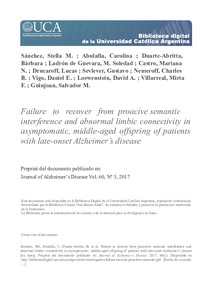Please use this identifier to cite or link to this item:
https://repositorio.uca.edu.ar/handle/123456789/1452| Título: | Failure to recover from proactive semantic interference and abnormal limbic connectivity in asymptomatic, middle-aged offspring of patients with late-onset Alzheimer’s disease | Autor: | Sánchez, Stella M. Abulafia, Carolina Andrea Duarte-Abritta, Bárbara Ladrón de Guevara, María Soledad Castro, Mariana N. Drucaroff, Lucas J. Sevlever, Gustavo Nemeroff, Charles B. Vigo, Daniel Eduardo Loewenstein, David A. Villarreal, Mirta F. Guinjoan, Salvador M. |
Palabras clave: | ENFERMEDAD DE ALZHEIMER; DETERIORO COGNITIVO; SISTEMA LIMBICO; INMUNOLOGIA | Fecha de publicación: | 2017 | Editorial: | IOS Press | Cita: | Sánchez, S. M., et al. Failure to recover from proactive semantic interference and abnormal limbic connectivity in asymptomatic, middle-aged offspring of patients with late-onset Alzheimer’s disease [en línea]. Preprint del documento publicado en Journal of Alzheimer’s Disease. 2017, 60 (3). doi:10.3233/JAD-170491. Disponible en: https://repositorio.uca.edu.ar/handle/123456789/1452 | Resumen: | Background: We have obtained previous evidence of limbic dysfunction in middle-aged, asymptomatic offspring of lateonset Alzheimer’s disease (LOAD) patients, and failure to recover from proactive semantic interference has been shown to be a sensitive cognitive test in other groups at risk for LOAD. Objective: To assess the effects of specific proactive semantic interference deficits as they relate to functional magnetic resonance imaging (fMRI) neocortical and limbic functional connectivity in middle aged offspring of individuals with LOAD (O-LOAD) and age-equivalent controls. Methods:We examined 21O-LOADand 20 controls without family history of neurodegenerative disorders (CS) on traditional measures of cognitive functioning and the LASSI-L, a novel semantic interference test uniquely sensitive to the failure to recover from proactive interference (frPSI). Cognitive tests then were correlated to fMRI connectivity of seeds located in entorhinal cortex and anterodorsal thalamic nuclei among O-LOAD and CS participants. Results: Relative to CS, O-LOAD participants evidenced lower connectivity between entorhinal cortex and orbitofrontal, anterior cingulate, and anterior temporal cortex. In the offspring of LOAD patients, LASSI-L measures of frPSI were inversely associated with connectivity between anterodorsal thalamus and contralateral posterior cingulate. Intrusions on the task related to frPSI were inversely correlated with a widespread connectivity network involving hippocampal, insular, posterior cingulate, and dorsolateral prefrontal cortices, along with precunei and anterior thalamus in this group. Different patterns of connectivity associated with frPSI were observed among controls. Conclusion: The present results suggest that both semantic interference deficits and connectivity abnormalities might reflect limbic circuit dysfunction as a very early clinical signature of LOAD pathology, as previously demonstrated for other limbic phenotypes, such as sleep and circadian alterations. | URI: | https://repositorio.uca.edu.ar/handle/123456789/1452 | ISSN: | 1387-2877 | Disciplina: | MEDICINA | DOI: | 10.3233/JAD-170491 | Derechos: | Acceso Abierto | Fuente: | Preprint del artículo publicado en Journal of Alzheimer’s Disease, Vol. 60, Nº 3, 2017 |
| Appears in Collections: | Artículos |
Files in This Item:
| File | Description | Size | Format | |
|---|---|---|---|---|
| failure-recover-proactive-semantic.pdf | 696,91 kB | Adobe PDF |  View/Open |
Page view(s)
205
checked on Apr 27, 2024
Download(s)
328
checked on Apr 27, 2024
Google ScholarTM
Check
Altmetric
Altmetric
This item is licensed under a Creative Commons License

